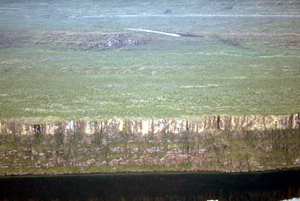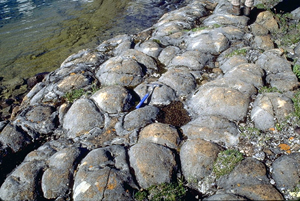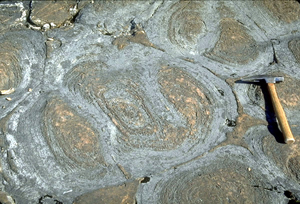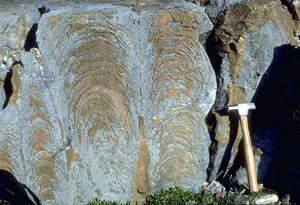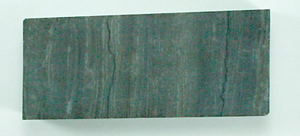|
We inhale air unconsciously every day. By taking in air, we absorb oxygen
and discharge carbon dioxide in the process of generating energy. It is
a physiological phenomenon, called respiration. Most organisms on earth
breathe. Then, how is oxygen generated and where does carbon dioxide go?
A school textbook taught us that photosynthetic organisms discharge oxygen
in exchange of absorbing carbon dioxide. Photosynthetic organisms decompose
carbon dioxide in order to absorb carbon, which becomes a component of
their bodies.
If oxygen is solely generated from photosynthetic organisms, it means
that the birth of oxygen originates in the birth of the organisms, and
until then the world had been the place without oxygen. In other words,
the generation of oxygen and the birth of photosynthetic organisms on
earth are identical.
When did the first photosynthetic organisms appear on earth? The answer
can be found in fossils and remains of the organisms.
Fossils of cyanobacteria, the first photosynthetic organism appeared on
earth, have been discovered from the stratum of approximately 3.2 billion
years ago. There is another theory, which states photosynthetic organism
existed even before that, but it fails to get consensus from scientists.
The dominant theory is that the first photosynthetic organisms appeared
on earth approx. 3.2 billion years ago and from the fact that huge amount
of cyanobacteria fossils were discovered concentrated in the stratum of
approx. 2.7 billion years ago, the organisms have irrupted at that time.
The fossils were discovered from rocks called "stromatolite". In the cross
section, a stromatolite is a concentric circle of a few score centimeters
diameter and about 1m high. Numerous layers at a space of as small as
a few millimeters can be found in the vertical section of a stromatolite,
altogether forming a mushroom-like pattern. This duplicate layer system
of a stromatolite is made of numerous clusters of minute cyanobacterias.
Great many stromatolites were discovered from the stratum of approx. 2
billion years ago in the eastern shore of Great Slave Lake in Northern
Territory of Canada. Of all the stromatolites I have ever seen, landscape
there was the most overwhelming.
Numerous stromatolites are stretched all along the lakeside. Just imagine
very big mushrooms are tightly placed as far as you can see. Even up from
the sky on a hydroairplane, I could confirm the magnitude of the scale.
I have mentioned in the previous essay that the sudden increase of oxygen
in seawater led to the deposit of iron ore in the sea bottom. The sudden
increase of oxygen was caused by the irruption of cyanobacteria. Huge
amount of iron ores and huge amount of stromatolites had been formed almost
coincidently with a strong correlation.
A cyanobacterium is the first organism that generated oxygen on earth.
What would the world have been like if there had been no oxygen at all?
Atmosphere must have been mainly consisted of carbon dioxide and nitrogen.
Oxygen changed the world upside down for creatures on earth. Almost all
the creatures on earth at present can intoxicate oxygen and utilize it,
through mitochondria in cells.
Organisms, which had lived on earth without oxygen, could no longer exist
ever since oxygen was added in the atmosphere. Because once oxygen intrudes
in cells of their body, all the components start to dissolve by oxidization.
In other words, for creatures, which did not have mitochondria, oxygen
worked as a highly toxic substance.
More than 2 billion years ago, sudden generation of oxygen caused by irruption
of cyanobacteria triggered an extensive destruction to earth's environment.
Global scaled pollution by oxygen resulted in massive extinction of species.
Although the actual facts about the extinction have not been revealed,
there is no doubt that the scale had been the largest of all the extinctions
on earth ever experienced in its history.
Environmental problems on earth are raised as points of issue in various
occasions now. But earth had lived through by far the larger catastrophe.
Wonderfully enough, some organisms had survived such catastrophe, and
others had learned to make use of the highly toxic substance and developed
an even more efficient system in their body. There is no doubt that such
organisms are the ancestors of human being as well as any other organisms
living on earth at present.
May 1st 2003
Yoshiyuki Koide
|
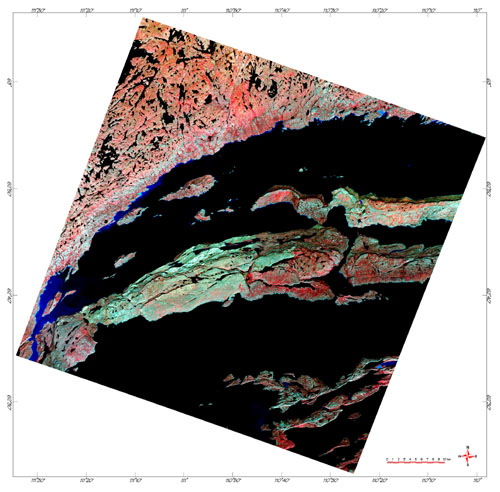
Image - 1 A satellite image of eastern
Great Slave Lake (ASTER/VNIR observed on November 2nd 2000)
For
enlargement (jpeg file 2.8MB)
This is the false color image
of one entire ASTER scene (60x60km), of eastern part of Great Slave Lake.
The colors red, green and blue are allocated to ASTER band 3, 2 and 1
respectively. The difference of stratums is well reflected by the difference
in colors.
This is an enlargement of
7x7km in Image - 1 centering on the stromatolite stratum. The stratum
can be separated in 5 parts based on the color appear in the image, mixture
of red and green (A in the image), thin stripe pattern with much green
and little white (B in the image), thick stripe pattern with much white
and little green (C in the image), stripe pattern with green and while
and sporadical red (D in the image) and red (E in the image). It corresponds
to the difference in types of rocks. Area A shows igneous rock in later
age (1.6~1 billion years ago), B shows dolomite stratum containing stromatolites,
C shows limestone, D shows dolomite with stromatolites older than B, and
E shows shale, the oldest stratum in the area. I talked about stromatolites
in D in the essay.
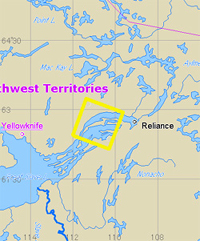
Figure-1 Location map
|

